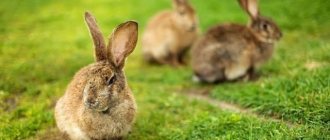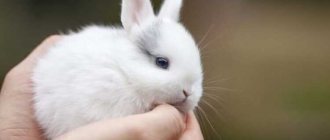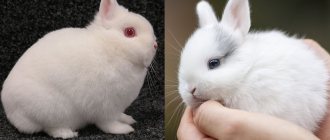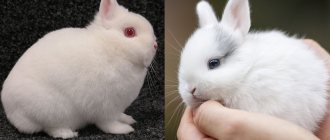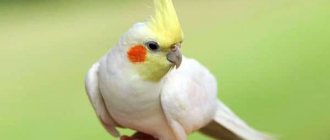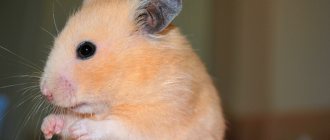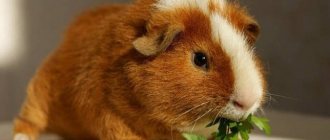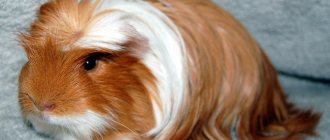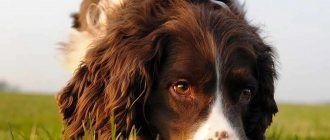How many years do decorative rabbits live at home? The lifespan of domestic fur-bearing animals depends on many factors, including belonging to a particular breed. This article will help you find out which decorative rabbits live longer and how to care for them to prolong their life.
Decorative rabbits
How long do decorative lop-eared rabbits live?
Fold rabbits have a playful nature, they are active and cute. They are loved by adults and children, because these animals easily find a common language with people and know how to show and accept tenderness. A characteristic feature of these animals is a compact, compact body, the back of which is widened, a flattened pretty face and drooping ears.
According to statistics, the average life expectancy of a rabbit with drooping ears is several years longer than that of pets with straight, erect ears. At home, with good care, they can live for about 8 years. This is the average. Some rabbits live up to 12-13 years.
Pets
The decorative rabbit has the lowest life expectancy. And this will not change either the first-class content or the ideal nutrition. Mini eared animals are sensitive to diseases and physical influences, which reduces their vital activity. Basically, such an animal will not live more than 4-6 years. Some representatives are able to boast a longer life span.
The lion-headed ornamental animal can live up to 10 years, which is a decent age for such animals. Fold rams can boast of the same results, although the majority of them do not survive the 7-year mark; some individuals surpass the 10-11-year mark.
Decorative animals were bred from the meat breed of Rex rabbits, the name of the breed is mini-Rex. Such an eared animal generally breaks all longevity records among rabbits; it is able to live up to 12 years, which seems incredible in relation to the life expectancy of indoor animals.
Dwarf rabbits live significantly shorter lives than representatives of other breed groups. Their life expectancy is almost the same as that of universal meat-and-down breeds.
How many years does a dwarf rabbit live?
Dwarf rabbit breeds are also in demand. These animals are distinguished by their good disposition, intelligence, and are trainable. Their advantage is compactness. The weight of a dwarf rabbit rarely exceeds 1.5 kilograms. Such pets can be kept even in a small apartment. Dwarf rabbits become attached to their owner and are easy to train, but their lifespan is not so long. On average, they live at home for 5-7 years, although cases of longevity have been recorded - some individuals can live up to 15 years.
Proper nutrition
How long a rabbit will live in an apartment also depends on how the person chooses the right diet for it.
These animals have one drawback: they are prone to obesity. This drawback is eliminated when preparing a daily menu for the animal. The main products he consumes are of plant origin. All that remains is to dose them correctly. Experienced breeders recommend feeding animals 6-7 times a day in small portions.
Animals willingly eat hay, cereals, herbs and vegetables. In addition, we must not forget about vitamins and beneficial microelements. They are contained in specialized feeds and supplements. But before giving them to your pet, you should consult your veterinarian. Not all breeds need standard vitamin complexes available on pet store shelves. The only thing that is not in doubt is the need to purchase a sharpening stone for teeth. This item will be a real salvation for the owners of the home, because every rabbit gnaws everything that gets in its way.
What affects lifespan?
In the wild, rabbits rarely exceed the age threshold of 3 years, but domestic pets are luckier: they do not suffer from predators, eat well, and are less stressed. The lifespan of pets is influenced by various factors:
Rabbit being examined by a veterinarian
- Infections. Decorative rabbits have a very weak immune system. They can die in a matter of days from infectious diseases: myxomatosis, coccidiosis, VGBV, rhinitis and stomatitis.
- Traumatic factor. If a rabbit falls from a height, it can break its spine or damage its internal organs. It is important to ensure the safety of your pet to avoid an unfortunate death at an early age.
- Genetics. Just like human health, rabbits are affected by heredity. Healthy parents give birth to children with strong immunity. The same rule applies to animals.
- Nutrition. The diet of an eared animal must be properly balanced. A lack of nutrients, vitamins and microelements in the body always has a detrimental effect on health: vitamin deficiencies and various diseases develop, and immunity decreases.
- Hygiene. If a rabbit is kept in unsanitary conditions and neglected to clean the cage and disinfect it, there is a high probability of developing diseases.
- Stress. Decorative rabbits have a sensitive nervous system. Frightened, they may die from a broken heart. It is important to provide the animals with peace and avoid situations that could cause fear or shock. Loud sharp sounds, changes in environment, medical procedures, car trips - small animals are afraid of all this.
- Castration and sterilization. A rabbit will live several years longer if it is castrated at a young age. The same goes for female rabbits. Frequent bearing of offspring and feeding of cubs takes away the female's strength, and her body wears out faster. If you do not plan to purchase a pair for a decorative rabbit, you should think about castration.
Conditions for longevity
The decorative rabbit is a creature with a delicate immune system, and few breeders can keep it in good condition. It is the state of health of animals that most often influences the fact that furry creatures leave this world just a few years after birth. To maximize the life of your pets, you should:
- undergo regular veterinary examinations and vaccinations;
- monitor the quality of the animal’s diet;
- take good care of it;
- castrate males;
- Organize daily walks for the animal.
Also, the life expectancy of domestic animals depends on:
- breeds;
- the health of the rabbit's parents;
- the presence or absence of genetic defects;
- predisposition to diseases.
Every experienced breeder knows how to determine whether a rabbit is old or not. Dwarf rabbits kept in regular home cages lose the sparkle in their eyes as they age. The quality of the coat also deteriorates: it begins to fade and thin out. The previously noticed activity and playfulness disappear. Often, in old age, eared cats become fat and develop a saggy belly. In addition, these animals are shy, and this is a serious problem. A rabbit may even die due to severe fright.
You should not feel sorry for your pet, fearing that castration will bring him a lot of pain and inconvenience. According to the results of numerous studies, operated males and females please their owners for several months longer than their full-fledged relatives. This difference is determined by the reduction in the risk of tumors of the genital organs, which are observed in these animals in at least 20% of cases. In addition, these data were obtained from a study of individuals who had previously undergone regular mating. Rabbits kept in home cages are most often deprived of this opportunity. This increases the risk of cancer.
Signs of old age
The owner will definitely notice age-related changes occurring in the pet. Young rabbits are playful and active, unlike older ones. They show interest in new toys, run around, play pranks, and can rarely be found at rest. When old age sets in, physical activity decreases. The animal spends most of its time lying down; it is difficult to interest it in games.
Reference. The character of the animal also changes over the years: an old rabbit quickly gets irritated and becomes capricious.
The appearance of yellow plaque on the teeth is a sign of an old rabbit.
There are other signs of aging, they relate to physiological changes:
- The appearance of yellow plaque on the teeth. A one-year-old pet’s teeth are already covered with a yellowish coating, and over the years they become even darker.
- Eyes. In older rabbits, the lenses become cloudy, and the eyelids become lumpy and dark spots appear on them.
- Stomach. The skin on the abdomen of an old rabbit sags.
- Wool. In young individuals, the fur is thick and shiny, but with age its appearance deteriorates - it thins out and looks unkempt.
Advantages and disadvantages
If you are seriously thinking about getting a dwarf sheep rabbit as a pet, you should familiarize yourself with all the possible pros and cons of such a decision.
- Among the advantages, these animals have the following qualities:
- Flexibility. This breed of decorative rabbits is considered the most tame. They quickly get used to people and willingly communicate with them.
- Ability to quickly get used to the crate and tray. You won't have to spend a lot of time and effort explaining to your little lamb where his place to sleep and the toilet are.
- The appearance of these lop-eared rabbits will not leave anyone indifferent. Their soft fluffy fur, cute floppy ears and the naive look of their large almond-shaped eyes delight both children and adults.
- The small size of adults of this breed, which is often limited to 1–2 kg. For such kids there is easily enough space in any, even small apartment.
- However, rabbits of the dwarf ram breed are also characterized by other, less positive characteristics:
- They don't like heat. When determining a place for the cage where the little ram will live, the owners should choose a place that will be protected from direct sunlight, radiators and heaters.
- They are afraid of drafts. The rabbit's cage should be located away from open windows and doors to minimize the risk of your pet catching colds.
- They love to chew on everything that comes their way. When letting the little ram walk around the apartment, it should not be left alone for a long time without supervision. Flowers, electrical wires, furniture legs, shoes - all this can be tested by a little fidget.
How to extend lifespan?
For a rabbit to live a long life, it is important to show it love and care. When purchasing a baby rabbit, it is worth asking about its pedigree, who its father and mother were, and how healthy they were. Knowing what diseases the pet is predisposed to, the owner will be able to pay attention to prevention, working in the right direction.
You can protect your animal from diseases if you vaccinate on time. Vaccinations will help prevent life-threatening infections for your pet. This is especially important to do if the owner plans to walk the pet outside on a leash.
Physical activity is beneficial for a decorative rabbit. In order for the rabbit to lead an active lifestyle, you should choose a spacious cage, and place ladders, tunnels, and a wheel inside it. It’s good if the animal spends at least an hour and a half a day outside its cage, walking around the apartment, and even better - in the fresh air. These are the main rules thanks to which the decorative rabbit will be healthy and be able to live a long life. Let’s consider what else will help prolong your pet’s lifespan below.
Keeping it clean
The cage is cleaned regularly, cleared of droppings, the floor, bars and trays, drinking bowls and feeders are disinfected. The room where the pet's cage is located should not be dusty. You need to wash the floor and wipe the furniture with a damp cloth.
The cage must be perfectly clean
It is important to keep the animal’s fur clean and comb it out so that tangles do not form. This is especially important during shedding. If you do not comb the fur, the rabbit, while licking itself, will eat the hair, as a result it may die from intestinal blockage.
Attention! You cannot bathe a decorative rabbit. Partial washing of the paws and hindquarters is allowed if the pet is soiled with feces. A wet rabbit should not be released onto the floor until its fur is dry.
Conditions of detention
Rabbits are sensitive to drafts and dampness . When an animal is in such conditions, its immunity decreases. A cold can lead to the death of an animal. Rabbits also do not do well in hot and stuffy rooms. The cage should not be located on the windowsill so that the pet does not suffer from drafts and overheating in the sun.
Nutrition
In addition to feed, the animal’s diet includes good quality hay, vegetables, herbs, and tree branches. In winter, it is worth strengthening his immunity with vitamin and mineral supplements. You can't feed a rabbit:
- sausages;
- meat;
- sweets and pastries;
- wet grass;
- poisonous plants;
- moldy hay;
- rotten vegetables.
Attention! Acquaintance with new products is carried out gradually.
Safety
It is recommended to install the pet's cage on a hill, that is, on a cabinet or table. It is important to ensure that the door is securely fixed so that the rabbit cannot open it itself and fall down. It is unacceptable to drop the animal or step on it: it may die from injuries.
The rabbit's place must be safe.
Protection from stressful situations
Do not expose your rabbit to stress. It is better to protect it from collisions with other pets that may frighten the animal. You should not shout loudly in the presence of a decorative rabbit, or use a drill or vacuum cleaner.
Treatment
If your rabbit is sick, you should immediately contact a veterinarian rather than try to cure it yourself. Some diseases develop rapidly and can kill an animal very quickly. Do not neglect routine vaccination.
How long a decorative rabbit will live at home depends in most cases on its owner and on what living conditions he provides for the animal. When purchasing an animal, you need to be ready to give it love and care, spend time and money on treatment, play and walk with the rabbit. Then he will live a long life.
Common Causes of Early Death
There are a number of recommendations that will help to significantly increase the life expectancy of decorative rabbits.
- do not give the animal food from the common table (sweets, meat, bread, crackers);
- in order to prevent the development of colds, do not let your pet walk in a draft or near heating devices;
- Babies need to be bathed extremely rarely; after bathing, the baby rabbit needs to dry thoroughly, so keep it in a dry towel until completely dry;
- do not allow the animal to be injured, so do not drop or step on the pet;
- to grind down the incisors, which grow throughout their lives, rabbits need to be given information from trees and shrubs;
- domestic rabbits have difficulty withstanding high temperatures, stuffiness, high humidity and dampness;
- hay, like other products, should not be rotten or wet;
- It is recommended to accustom animals to new products gradually;
- domestic eared cats need vitamins and minerals;
- The water in the sippy cup should be clean and at room temperature.
Any pet needs attention and affection. Then the question of how many years decorative rabbits live will disappear on its own. An active and playful animal lives to the maximum.
What determines life expectancy?
The lifespan of rabbits is determined by a large number of reasons:
- Heredity. If the ancestors were distinguished by longevity, then the pet has every chance of a long life.
- Nutrition. A balanced diet rich in all essential microelements has a positive effect on your pet’s immune system and overall health, which definitely increases the chances of a long life.
Note: the digestive system of decorative rabbits is significantly weaker than that of ordinary rabbits!
- Living conditions. You need to keep your pet in comfortable conditions and perform all necessary care procedures. A permissive attitude (dirty cage, stagnant water, bad climatic conditions) is unacceptable.
- Diseases. Regardless of its severity, each disease increases the risk of short life. Infectious diseases that undermine health are dangerous.
- Injuries. Create a comfortable environment for your pet with the least risk of injury.
- Stressful situations. Rabbits have a sensitive nervous system: severe fear, panic or shock can provoke death. Systematic screams, scandals and simply a tense emotional situation in the house have a heavy impact on the rabbit’s psyche.
- Castration. Sterilized animals are in better health, their bodies age more slowly, and are not as susceptible to diseases of the genitourinary system, which often cause death in these animals.
- Health. Strengthen the animal's immunity.
- Affection and care. Give the animals as much attention as possible; positive emotions have a positive effect on the quality of life. Mental harmony is the best medicine that prolongs years.
Lifespan
On average, these furry rodents live for about 6–8 years, but there are cases where pets have even lived up to 11 years. The exact lifespan of an animal depends on care and living conditions, so those who would like to extend the life of their pet should monitor the following factors:
- take an interest in the pedigree of a purebred animal, do not buy it from random sellers, otherwise genetic problems or simply health defects of the parents will make a particular individual insufficiently resistant to diseases;
- try to take care of the rabbit so that it does not get sick, also create conditions in which the risk of injury is minimized, but in case of any problems, immediately contact a veterinarian;
- choose the right menu for your pet and follow simple recommendations regarding its daily care;
- Remember that in nature a rabbit is an active animal, so provide it with opportunities for active walks.
Among other things, a certain part of the vital energy of any animal is spent on ensuring the reproductive instinct, and the inability to realize such a need when it exists shortens life expectancy.
